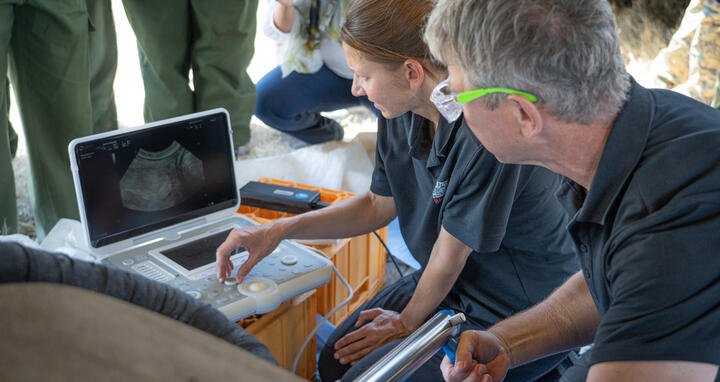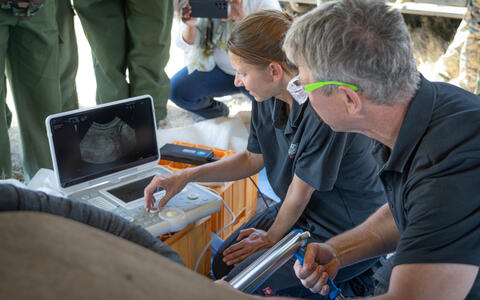The first successful transfer of a rhino embryo
There are only two northern white rhinos remaining in the world: Najin and her daughter Fatu live in Kenya, at the Ol Pejeta Conservancy. To save the subspecies, the international BioRescue consortium, which includes the Max Delbrück Center, has already created 30 northern white rhino embryos. These are stored in liquid nitrogen at minus 196 degrees Celsius in Berlin and Cremona, Italy and are awaiting transfer to surrogate mothers of the southern subspecies. Before this could go forward, however, the team had to demonstrate that their concept works — and has now confirmed a 70-day pregnancy with a well-developed and viable 6.4-centimeter-long male fetus.
Susanne Holtze and Thomas Hildebrandt from the Leibniz-IZW implant two southern white rhino embryos into the surrogate mother Curra.
On September 24, 2023, the BioRescue team, led by the Leibniz Institute for Zoo and Wildlife Research (Leibniz-IZW) in Kenya, transferred two southern white rhino embryos to the surrogate mother Curra, also a southern white rhino. The eggs came from Elenore from the Pairi Daiza zoo in Belgium, and the sperm from Athos from the Salzburg Zoo in Hellbrunn, Austria. The artificial fertilization and development into blastocysts were carried out by Avantea Laboratories in Cremona.
Embryo transfer in rhinos is uncharted territory. The BioRescue team developed the method — including protocols and equipment with which they can find and reach the location where the embryo is introduced into the two-ton animal. The University of Padua ethically evaluates these transfers.
A milestone under tragic circumstances
When the team went to check on Curra's pregnancy at the Ol Pejeta Conservancy on November 28, 2023, the surrogate mother was dead. Following extreme rainfall, clostridia spores had come to the surface from deeper layers of the soil. The autopsy of Curra and another bull revealed a severe systemic infection with clostridia — a bacterial toxin had poisoned the animals. However, Curra had been pregnant with a male fetus. Genetic analyses at the Max Delbrück Center and the Leibniz-IZW in Berlin confirmed that this was the transferred embryo.
"We are overwhelmed by the fact that this technique works so well," says Professor Thomas Hildebrandt from the Leibniz-IZW and BioRescue project leader. "It's bitter that this milestone is confirmed under such tragic circumstances. But I'm certain that this evidence will be a turning point for the survival of the northern white rhino."
To protect all the rhinos living in human care, including Najin and Fatu, the BioRescue team, which includes the Kenya Wildlife Service, the Wildlife Training and Research Institute, the Ol Pejeta Conservancy, and the Safari Park Dvůr Králové, have launched a vaccination program. They have quarantined affected areas and fenced in new protective enclosures. The incident is causing a delay in the application of the research findings to species conservation, as new surrogate mothers must be selected, among other things.
Expanding genetic diversity
For now, we and our colleagues are delighted with the proof that surrogacy of laboratory-generated embryos is possible.
"We want the offspring to live with Najin and Fatu to learn social behavior from their peers. So we are in a hurry to bring a northern white rhino baby into the world — with this proof of concept, it can be done in two to three years," says Hildebrandt.
The project, funded with six million euros by the Federal Ministry of Education and Research since 2019, combines reproductive and stem cell technologies. Dr Sebastian Diecke and Dr Vera Zywitza from the Max Delbrück Center are working with a Japanese team to generate additional sperm and egg cells from the cells of twelve deceased northern white rhinos. "This will allow us to increase genetic diversity," says Sebastian Diecke. “But for now, we and our colleagues are delighted with the proof that surrogacy of laboratory-generated embryos is possible."
IZW, Max Delbrück Center







